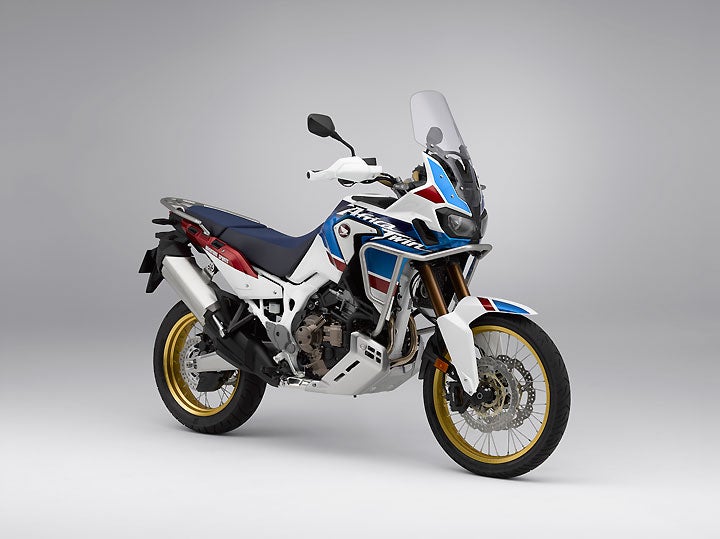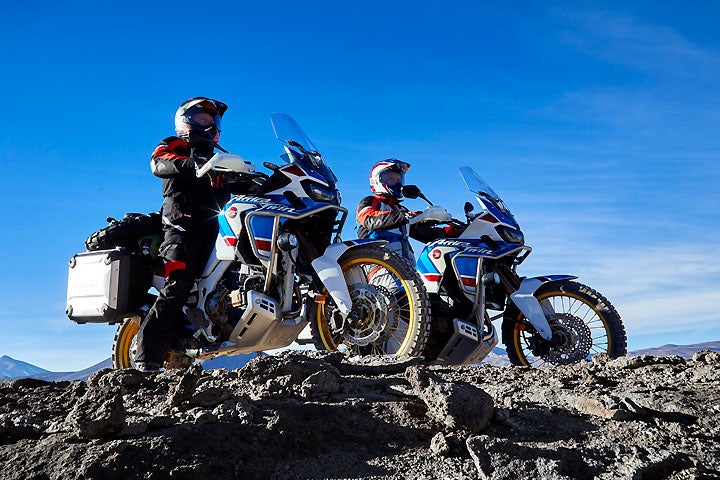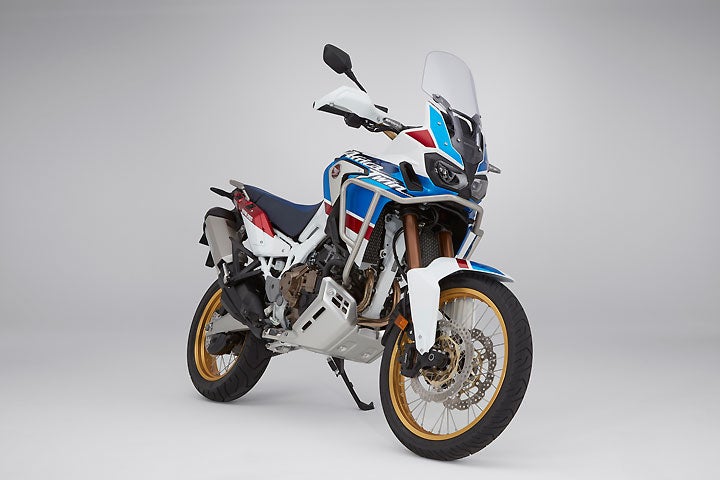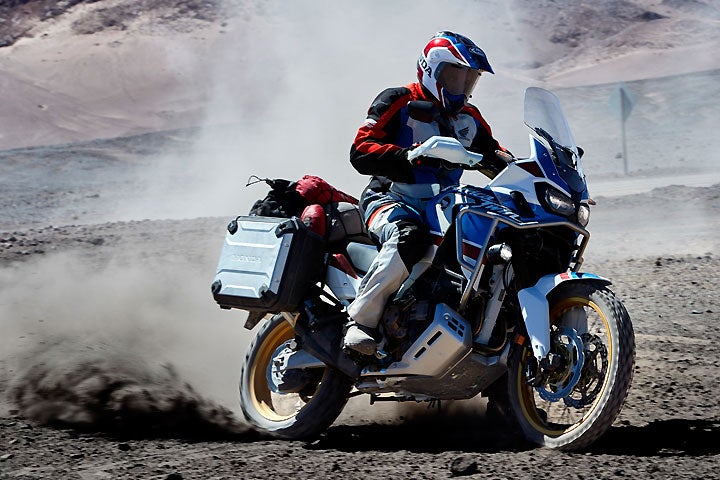Nov 6, 2017 – MILAN, Italy–Honda’s Africa Twin platform grows today with the announcement of the 2018 CRF1000L2 Africa Twin Adventure Sports, which was introduced alongside an updated standard 2018 CRF1000L Africa Twin at the EICMA motorcycle show in Milan.

Following a European release early next year, both models will be available in the U.S. in summer of 2018. Suggested retail price for the Adventure Sports model is approximately $2000 higher than that of the current Africa Twin.
Displayed previously in concept form, and developed as a powerful extension of the “True Adventure” mantra that drives the Africa Twin platform, the new Adventure Sports version features increased suspension travel, added ground clearance, enhanced creature comforts and a larger fuel tank for extended range. Both the Adventure Sports and the standard Africa Twin feature a long list of updates to the engine, electronics, and rider interface, while continuing to offer an ideal balance of power and light weight.
“The Africa Twin’s success on showroom floors and in comparison tests is evidence of the platform’s profound capabilities, but the Adventure Sports model expands the possibilities by making it possible to ride further and more comfortably,” said Lee Edmunds, American Honda’s Manager of Motorcycle Marketing Communications. “We’ve enjoyed seeing our customers put their own interpretations on the Africa Twin’s ‘True Adventure’ ethos, and with the increased capabilities of the new Adventure Sports, as well as those of the updated standard Africa Twin, we expect that spirit will be applied in new and exciting ways.”
COLORS
CRF1000L2 Africa Twin Adventure Sports: White/Blue/Red
CRF1000L Africa Twin: TBA
Availability: Summer 2018
KEY FEATURES
-The Africa Twin Adventure Sports has a larger fairing matched with an 80mm taller screen to offer greater wind protection, and comes standard with heated grips and a 12 volt accessory socket, facilitating longer tours in wide-ranging conditions
-The Adventure Sports model comes standard with larger sump guard and front light bars, as well as brushed-aluminum cowling panels, rear mudguard, and easily removable steel rack
-The Adventure Sports model has larger, 6.37-gallon fuel tank (compared to 4.97 gallons on the standard model), extending range
-Both CRF1000L Africa Twin models now have auto-canceling turn indicators
-The Adventure Sports model’s seat features a flatter profile and a 1.2-inch-taller height than standard model. The seat adjusts .8 inches, for a seat height of either 35.4 inches or 36.2 inches (compared to 33.5 inches and 34.3 inches). Handlebar position is 1.3 inches higher and .2 inches rearward compared to the standard version
-The Adventure Sports model has a storage pocket on rear right.
-On both models, the rider’s foot pegs are now wider and affixed via stouter steel mounting plates, whereas the passenger foot-peg hangers have been redesigned to allow more room for the rider’s feet when standing.
-On both models, instruments are positioned at a shallower angle to allow the rider to see them more easily from a standing position.

-The Adventure Sports model has updated, longer-travel Showa suspension, resulting in 10.6 inches of ground clearance (compared to 9.8 inches). On both models, shock preload, rebound damping, and compression damping are fully adjustable.
-Both models have compact two-piece, radial-mount, four-piston front-brake calipers and “wave” floating rotors front and rear. The lightweight two-channel ABS can be turned off at the rear.
-Both models feature front and rear wheels in size 21 and 18 inches, respectively, with stainless-steel spokes for improved durability
-On both models, the 998cc SOHC eight-valve parallel-twin engine is updated with a new airbox, now featuring a 20mm longer funnel length and matched to redesigned exhaust internals that significantly improve midrange response and sound quality.
-On both models, the engine’s balancer-shaft weights have been lightened by 10.6 ounces for added character and feel in power delivery
-The water pump is housed within the clutch casing, with a thermostat integrated into the cylinder head, while water and oil pumps are driven by the engine’s balancer shafts, contributing to a compact engine and optimum ground clearance.
-New for 2018, a lithium-ion battery is 5.1 lbs. lighter than the previous lead-acid unit.
-Both versions available with Honda’s advanced automatic Dual Clutch Transmission (DCT), delivering consistent, quick, seamless gear changes on-road or off. Rider can select from three different shifting modes, and a G switch enhances off-road functionality by reducing the amount of clutch slip during gear changes
-New for 2018, both Africa Twin models have Throttle-By-Wire system (TBW), opening the door to four individual riding modes and an expanded Honda Selectable Torque Control (HSTC) system
-HSTC now features seven levels (up from three), to adapt to a wide variety of conditions. HSTC can also be completely switched off, and three levels of power and engine braking are available.

DESIGN
The Africa Twin Adventure Sports’ styling is less minimalist than that of the Africa Twin; the dual headlights are shared but the new model has a larger fairing matched with an 80mm taller screen to offer greater wind protection. It also comes standard with heated grips and a 12V accessory socket, facilitating longer tours in wide-ranging conditions.
The Adventure Sports model comes standard with a larger sump guard and front light bars. Brushed-aluminum cowling panels add tough appeal and class to this adventure-ready machine, while the rear mudguard and steel rack can be easily removed. Aluminum side cases are available, as is an aluminum top box with mounting equipment specific to the CRF1000L2 Africa Twin Adventure Sports. Thanks to a 1.4-gallon larger, 6.37-gallon fuel tank (compared to 4.97 gallons on the standard model), range for the Adventure Sports model is extended.
On both Africa Twin models, the turn indicators now auto-cancel. Rather than using a simple timer, the system detects differences in front and rear wheel speed and calculates when to cancel the indication relative to the situation.
ERGONOMICS
For extended off-road use, the Adventure Sports’ seat features a flatter profile, and seat height is 1.2 inches higher than the standard model. The seat adjusts .8 inches, for a seat height of either 35.4 inches or 36.2 inches (compared to 33.5 inches and 34.3 inches); there’s also a rear storage pocket tucked away on the right side. To match the raised seat height, the handlebar position is 1.3 inches higher and .2 inches further back than that of the standard model, resulting in a more upright riding position.
On both CRF1000L Africa Twin models, the rider’s foot pegs are now wider and affixed via beefed-up steel mounting plates. The passenger foot-peg hangers have been redesigned to allow more room for the rider’s feet when standing, and the instruments are positioned at a shallower angle to allow the rider to see them more easily from a standing position. These updates benefit riders in off-road situations, an area where the tractable Africa Twin already stands out thanks to its user-friendly performance and size.

CHASSIS/SUSPENSION
The 2018 Africa Twin and Africa Twin Adventure Sports share a steel semi-double-cradle frame that provides nimble on-road manners plus stable high-speed characteristics, as well as genuine off-road capability. Thanks to updated Showa suspension, the Adventure Sports offers 10.6 inches of ground clearance (.8 inches more than the Africa Twin). Each has a wheelbase of 61.2 inches, and rake/trail figures of 27.5°/4.5 inches. Curb weight for the Adventure Sports is 533 pounds (556 pounds DCT), while the standard model weighs in at 507 lbs. (529 pounds DCT).
The Adventure Sports’ updated 45mm Showa cartridge-type inverted fork has 8.9 inches of suspension stroke (up .9 inches from the standard Africa Twin), offering excellent long-travel performance. At the Adventure Sports’ rear, a similarly revised Showa shock delivers 9.4 inches of travel, up .8 inches.
On both models, the shock has a low upper mount for mass centralization, and it features a 46mm remote reservoir for stable damping control under more extreme off-road conditions. Spring preload can be adjusted via a dial on the shock body; rebound and compression damping are also fully adjustable.
Compact two-piece, radial-mount, four-piston calipers work dual 310mm “wave” floating rotors through sintered pads and serve up consistent stopping power and feel on-road or off. The rear rotor has a diameter of 256mm and also features a “wave” design. The lightweight two-channel ABS can be turned off at the rear.
True to their off-road heritage, the Africa Twin models feature spoke front and rear wheels in size 21 and 18 inches, respectively, wearing 90/90-21 and 150/70-18 tires. The spokes are manufactured in stainless steel for improved durability and ease of care.
ENGINE
The 998cc SOHC eight-valve parallel-twin engine used in both Africa Twin models is updated with a new airbox, now featuring a 20mm longer funnel and matched to redesigned exhaust internals that significantly improve midrange response and sound quality. The two-into-one downpipe now feeds exhaust through two catalyzers (up from one) into a simplified, smaller-volume muffler (4 liters instead of 4.6) that houses two chambers rather three.
Bore and stroke are set at 92 x 75.1mm, with a compression ratio of 10.0:1; the 270° phased crankshaft and uneven firing interval create the engine’s distinctive throb and feel for rear-wheel traction.
For 2018, the engine’s balancer-shaft weights have been lightened by 10.6 ounces for added character and feel in power delivery. As was the case before, the crankcases are split vertically; the water pump is housed within the clutch casing, with a thermostat integrated into the cylinder head. The water and oil pumps are driven by the engine’s balancer shafts. These features contribute to the engine being compact and short, and to optimum ground clearance, a crucial element to off-road performance.
Four-valve cylinder heads, fed by PGM-FI fuel injection, each employ twin spark plugs and dual and sequential ignition control for even combustion. Honda’s SOHC Unicam® valve train is a feature of the CRF450R and the low-set position of the cast camshaft contributes to the compact nature of the cylinder head. The inlet valves are 36.5mm in diameter, whereas the exhaust valves are 31mm.
The engine uses a semi-dry sump and in-tank lower-crankcase oil storage, allowing a shallow pan depth and reducing overall engine height. As the pressure-fed pump is located within the oil tank, there is no need for a pressure-feed passage, again saving weight and space.
Secondary vibrations are neutralized by the mutually reciprocating motion of the pistons, while primary inertial and coupling vibrations are cancelled by the use of biaxial balance shafts. The front balancer shaft uses two weights, the rear only a single weight.
On the manual-transmission versions, the aluminum clutch center and pressure plate use “assist” cams to ease shifting (with light lever feel) and “slipper” cams for deceleration and downshifting. Oil-gathering ribs on the main journal side of the primary gear ensure consistent lubrication for the gear, damper spring, and primary sub-gear. The lightweight six-speed manual gearbox uses the same shift-cam design as found on the CRF450R to ensure positive changes.
New for 2018, a lithium-ion battery is 5.1 lbs. lighter than the lead-acid unit of the 2017 Africa Twin and offers greater longevity, both in terms of life and the ability to retain a charge.
An optional quick-shifter is available.
DCT
Honda’s advanced automatic Dual Clutch Transmission (DCT) delivers consistent, rapid, seamless gear changes, and very quickly becomes second nature to use. It utilizes two clutches—one for startup and first, third, and fifth gears, the other for second, fourth, and sixth, with the main shaft for one clutch located inside that of the other.
Each clutch is independently controlled by its own electro-hydraulic circuit. When a gear change occurs, the system pre-selects the target gear through the clutch not currently in use. The first clutch is then electronically disengaged as the second clutch simultaneously engages. As the twin clutches transfer drive from one gear to the next with minimal interruption to rear-wheel drive, gear-change shock and pitching of the machine are minimized, resulting in shifts that are not only smooth, but direct.
The extra benefits of durability (as the gears cannot be damaged by missing a shift), impossibility of stalling, low-stress urban riding, and reduced rider fatigue add to the appeal of DCT.
Three modes of gear-change operation are available. Manual mode gives full manual control, allowing the rider to shift with the handlebar triggers. Automatic Drive mode is ideal for city and highway riding, and achieves optimum fuel efficiency. Automatic Sport mode offers three levels of sportier riding, as the ECU lets the engine rev a little higher before shifting up, and shifts down sooner when decelerating, for extra engine braking.
In either Drive or Sport mode, immediate manual intervention is possible; the rider simply selects the required gear using the up and down shift triggers on the left side of the handlebar. After an appropriate interval (depending on throttle angle, vehicle speed, and gear position), the DCT seamlessly reverts back to automatic mode.
The Africa Twin models’ DCT is also fully equipped to operate in an adventure environment, with off-road functionality enhanced by the G switch positioned on the right side of the instrument panel. In any riding mode, pushing the G switch reduces the amount of clutch slip during gear changes.
Further functionality for the DCT system comes in the form of incline detection, adapting the gear-shift pattern depending on the grade of an incline.
TECHNOLOGY
For 2018, the entire Africa Twin platform is updated by way of a Throttle By Wire (TBW) system that opens the door to four individual riding modes and an expanded Honda Selectable Torque Control (HSTC) system. The use of TBW greatly expands the choices available to the rider to manage engine output, feel, and rear-wheel traction. Whereas the 2017 Africa Twin had three levels of HSTC, plus OFF, the new system features seven levels—from Level 1, for aggressive riding off-road on block-pattern tires, to Level 7, for maximum sense of security on slippery, wet tarmac. It is still possible to turn HSTC completely off, and there are also three levels of power and engine braking available.
In a setup first used on the RC213V-S—the street-legal version of Honda’s MotoGP racer—three riding modes offer preset combinations of each parameter, suitable to different riding environments and scenarios:
TOUR mode employs the lowest Power (1), medium Engine Braking (2), and high HSTC (6).
URBAN mode uses mid-level Power (2) and Engine Braking (2), and high HSTC (6).
GRAVEL mode allows maximum Power (3) and Engine Braking (1), with high HSTC (6).
A fourth mode—USER—allows the rider to set and save his or her preferred combination of Power, engine braking, and HSTC levels. Riding mode and HSTC level can be changed at any time using the controls on the left switchgear.
HONDA ACCESSORIES
A full range of genuine Honda accessories is available for the CRF1000L2 Africa Twin Adventure Sports, including:
Touring bags
Aluminum luggage set
Rubber passenger foot pegs
DCT foot shifter
Fog lamps
Wheel stripes
Alarm system
Center stand
Sump guard
Lower and higher seats
The range of genuine Honda accessories available for the CRF1000L Africa Twin includes:
Top box and inner bags
Touring bags
Aluminum luggage set
Frame guard
Smoke windscreen
High windscreen
Upper and lower wind deflectors
Rubber passenger foot pegs
DCT foot shifter
Heated grips
12V accessory socket
Fog lamps with cowl mounting bar
Wheel stripes
Alarm system
Center stand
Sump guard
Lower and higher seats
 Your Privacy Choices
Your Privacy Choices